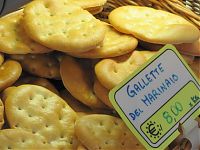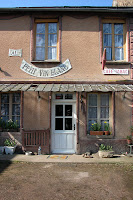 by David Downie
by David Downie
The Carilli brothers are no longer in business; the fine art of making traditional guanciale is threatened with extinction in Rome. But the memory of the Carilli brothers’ passion, and the lingering taste of their excellent products, live on in those of us who knew them. They also live on—perhaps to a lesser degree—in the remaining guanciale-makers of the city.

These are the best of the dozen or so norcinerie, salumerie, and salsamenterie in Rome that still make their own guanciale, the following are the best—to my knowledge. Each shop also sells a wide selection of other specialties, from dried mushrooms to farro (emmer), salami, grappa, sapa (reduced grape must) and artisanallypasta made by small, traditional producers.
Antica Norcineria— Giuseppe Simoni and his son Alberto, Umbrians by birth, operate one of Rome’s longest-established oldest pork butcher shops, which happens to be in via della Scrofa, “Sow Street.” The Simonis produce guanciale faster than the Carillis did; the cure lasts ten days and the aging about 20 days. But the results are excellent.
via della Scrofa, Rome, telephone 06.68806114
Baldassari Emma— A family-run salumeria that ages its guanciale for 45 to 90 days, enough time to develop complex flavor.
Piazza Unità, 28, Rome, telephone 06.3243252
Vincenzo Cecchini & C. —Virgilio Cecchini runs this family salumeria, in operation since 1930. Virgilio’s roots are in Collazzoni di Preci, six miles outside Norcia, and his hogs are raised in the mountains of Umbria and the adjacent Marche. Mild and fresh-tasting, Cecchini guanciale gets a sprinkling of mashed fresh garlic and sea salt before spending a week in a vat at just above freezing. Coated with black pepper or chili, it hangs for just a week or two in the shop’s marble-clad back room, so it must be cooked before it is eaten.
Via Merulana, 85, Rome, telephone 06.77207535
Norcineria Umbra — At this family run norcineria, the flavorful guanciali are aged for up to three months.
Via Pomezia, 28, Rome, telephone 06.77209695
America’s only guanciale maker?
Salumeria Biellese — To my knowledge, this Manhattan shop makes the only authentic Italian-style guanciale in America. Marc Buzzio sells his guanciale whole, averaging two pounds, small by Roman standards, mostly to upscale New York restaurants. The meat is Du Breton certified-organic Canadian pork. The jowls are cured for 35 days and strung up to dry for 45 days, so they can be eaten raw or cooked. The result is more compact in texture and drier than the Roman, and the flavor is with a delicately herby flavor. I’ve used this guanciale extensively to prepare classic Roman dishes (for example, when testing the recipes for my cookbook Cooking the Roman Way), and it compares favorably with the traditional Roman.
378 Eighth Avenue (at 29th Street), New York, New York 10001, telephone 212.736.7376, fax 212.736.1093
___________________________
David Downie is the author of Cooking the Roman Way: Authentic Recipes from the Home Cooks and Trattorias of Rome, and Food Wine Rome (a complete food- and wine-lover’s guide to the city); his latest book about Rome is Quiet Corners of Rome (over 50 silent, serene, often secret corners of the city). All three volumes are illustrated by color photographs by Alison Harris.











 by
by 




















